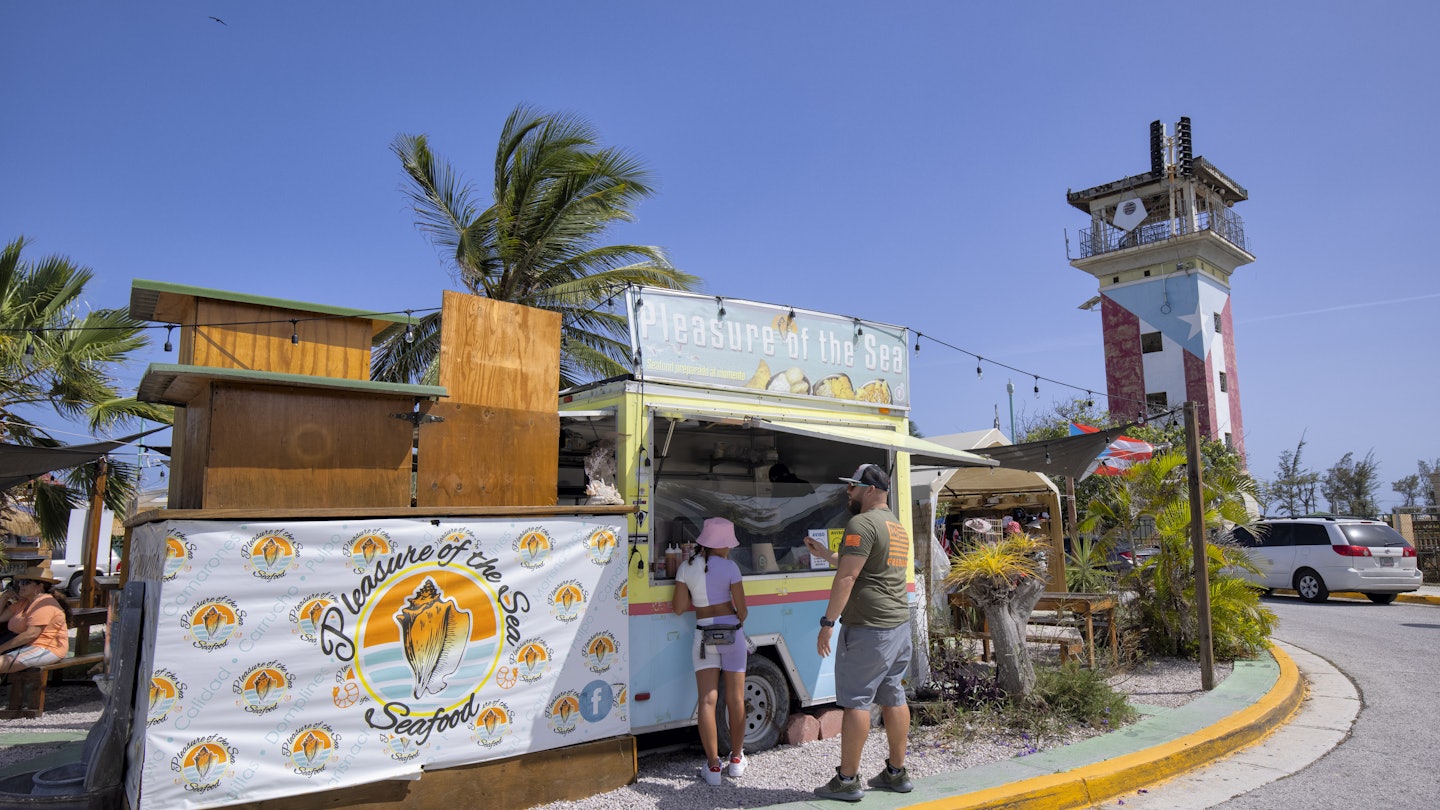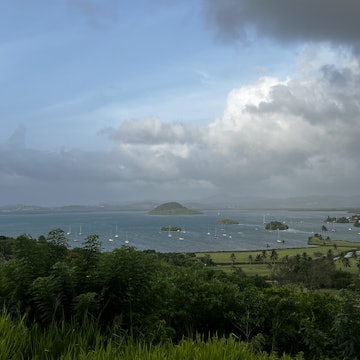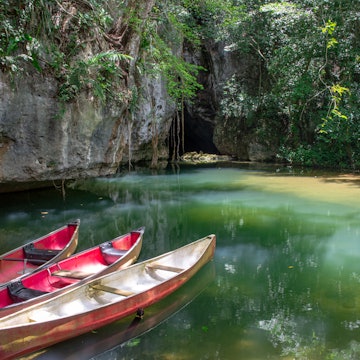

Try all the wonderful flavors of Puerto Rico with this guide to the island's food and drink © iStockphoto / Getty Images
Puerto Rico’s eclectic cuisine – cocina criolla – is an amalgamation of historical influences, from the island’s indigenous Taíno roots to the trans-Atlantic trade of enslaved people and Puerto Rico’s time as a Spanish colony before it became a US territory. It draws on ingredients from multiple cultures, as well as traditional cooking techniques, resulting in one of the most diverse and exciting culinary scenes in the Caribbean.
Throughout the year, boricuas (Puerto Ricans) celebrate Puerto Rican food culture in a series of food festivals across the island. The rest of the time, you can sample Puerto Rican staples everywhere, from fine dining establishments in the capital of San Juan, helmed by internationally renowned chefs, to roadside shacks in the mountains. Here are the best of the island’s specialties you cannot afford to miss.
Tuck in to empanadillas, quesitos and alcapurrias
Many cultures have a signature fried or baked pastry with a savory filling, and Puerto Rico is no exception. A popular snack and street food (available from food carts around San Juan and beyond), the empanadilla is a small, crescent-shaped pastry, its filling flavored with two essential Puerto Rico ingredients: sofrito (sautéed onions, garlic, and peppers, with olive oil and cilantro), and achiote (a nutty, sweet, spice made from annatto seeds).
The filling can be anything from ground beef and potatoes to lobster, conch, and shrimp. Two other worthwhile ambassadors of Puerto Rican street food are quesitos (cheese-filled pastries) and alcapurrias (deep-fried green banana fritters stuffed with seafood).
Where to try them: Kiosko El Boricua; street stalls during San Juan’s Fiestas de la Calle San Sebastián.

Taste the plantain dishes including tostones and amarillos
It’s impossible to imagine Puerto Rican food without the plantain, imported during the 16th and 17th centuries. Plantains are a Puerto Rican staple and for a good reason. It comes in many forms: tostones (green plantain slices marinated in water with garlic and lime juice, deep-fried, mashed, then deep-fried again till crispy), platanos fritos or amarillos (ripe plantain slices fried till the outside is blackened), mofongo (mashed plantain), pastelón (plantain lasagne), jibarito (plantain and steak sandwich), and guineos en escabeche (pickled green plantains).
Of those, you’re most likely to encounter the first two, typically served as an accompaniment to savory dishes. If you happen to be in the mountain town of Corozal in October, try the plantain’s various incarnations at the Fiesta de Platanos.
Where to try them: Tropical Taste, El Jibarito, Gustitos Criollos.
Get stuffed with pasteles
Puerto Rico’s answer to Mexican tamales, pasteles consist of masa (dough) made with green bananas (alternatives include grated green plantains and malanga/yutía – a root vegetable similar to yuca), stuffed with stewed pork (or occasionally chicken or salted cod). The ubiquitous softrito and achiote are typically used to flavor the filling, the whole thing is pressed onto a plantain leaf, folded, tied with string, covered in parchment paper and boiled.
Where to try them: El Jibarito, Deaverdura.

Munch on mofongo
This quintessential Puerto Rican dish dates back to the 1500s and traces its roots to the West African practice of making fufu (boiled yam mash). Drawing on the Angolan technique of combining starchy tubers with water and fat, mofongo is made by mashing fried green plantains, garlic, olive oil and chicharrón (fried pork skin), and is often served as a side dish alongside meat. Variations on the mofongo theme include yuca mofongo and trifongo, comprising a trio of tubers: green plantain, ripe plantain and yuca.
Where to try it: La Placita de Guavate, El Mofongo Ahogao, Orozco’s Restaurant.
Go restaurant hopping for lechón asado
On weekends, Puerto Rican families take part in chinchorreo (restaurant hopping) along the Ruta de Lechón (“Pork Highway”), to dine on lechón asado (whole roast pig) – so important that it’s been declared an official part of Puerto Rico’s gastronomic heritage. Lechonerías (rustic, open-air restaurants) line Ruta 184, aka “Pork Highway”, leading to the mountain town of Cayey. Each lechonería has its own jealously guarded seasoning recipe, but the pig is typically seasoned with adobo (mix of salt, pepper, oregano, garlic, achiote) and sometimes ajís dulces (mild sweet peppers), after which the pig is slow-roasted over hot coals using the low-and-slow barbacoa process (Taíno cooking method that gave us the word “barbecue”).
Where to try it: Lechonera Los Pinos, Lechonería Los Amigos.
Rice should be part of every meal
It’s not a proper meal if it doesn’t involve rice in one form or another. Two most popular side dishes are arroz y habichuelas and arroz con gandules. Arroz y habichuelas involves pink beans (stewed with sofrito, garlic, ham hock, onion and peppers) and white rice being served alongside each other. A little more complex, arroz con gandules comprises pigeon peas and rice, cooked with a base of sautéed salted pork and sofrito and then covered with broth and boiled.
Where to try it: Any restaurant on the island!
Try barbacoa, friturias de yautía and yuca en escabeche
Well over half of Puerto Ricans can trace their ancestry to the indigenous Taíno people – the island’s original inhabitants. You’re unlikely to encounter traditional Taíno dishes elsewhere on the island, but if you’re fortunate enough to attend the Festival Nacional Indígena, held mid-month in November, you’ll get to sample centuries-old island cuisine in the shape of barbacoa de pescado (fish cooked over a fire pit), friturias de yautía (fritters made from an endemic tuber) and yuca en escabeche (pickled cassava).
Where to try them: The town of Jayuya in the Central Mountains.

Local coffee beans give a rich flavor
Coffee is obviously not unique to Puerto Rico. That said, it’s been popular on the island since the 18th century, with small-scale coffee plantations dotted around the mountain towns of Adjuntas and Maricao (off the Ruta Panorámica) growing beans of excellent quality, with the volcanic soil giving them a deep, rich flavor. Maricao celebrates the brew during its Festival del Acabe del Café in February, but you can find good coffee year-round in cafes around San Juan, Ponce and elsewhere.
Where to try it: Don Ruiz Coffee Shop, Café Cuatro Sombras, Café Prieto.
Great piña coladas are not hard to find
Consisting of pineapple juice, coconut water, crushed ice and Don Q, Bacardi, or another Puerto Rican rum of your choice, the piña colada has been Puerto Rico’s national drink since 1978. Puerto Rico is the world’s biggest rum producer (70% comes from the island), with rum manufacturing dating back to the 1500s, and the pineapple even has its own festival in La Parquera, near Ponce.
Where to try it: La Guancha in Ponce; Festival de la Piña Paradisíaca in June in La Parguera, or pretty much any bar on the island.
Vegetarians and vegans
There is much more to Puerto Rico's meat- and dairy-free options than the ubiquitous arroz con gandules (rice with beans) and maduros (fried ripe plantain). With vegetarianism and plant-based diets becoming more and more popular in Puerto Rico itself, many chefs across the island are abandoning pork – the lynchpin of Boricua cuisine – and experimenting with meat-free versions of Puerto Rican edible treats, such as empanadillas, relleno de papa, and alcapurrias. Vegetarian and vegan restaurants, such as Madre Tierra and St Germain Bistro & Café, are particularly abundant in San Juan, but you can find them in other corners of the island as well.














